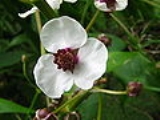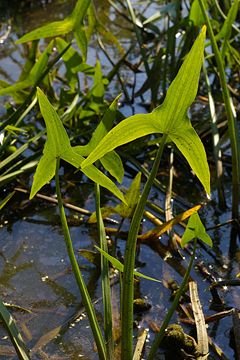
Sagittaria sagittifolia
Encyclopedia
Sagittaria sagittifolia (also called arrowhead due to the shape of its leaves) is a flowering plant
in the family Alismataceae
, native to wetland
s throughout the temperate regions of Europe
and Asia
; in Britain it is the only native Sagittaria.
It is a herbaceous
perennial plant
, growing in water from 10-50 cm deep. The leaves
above water are arrowhead-shaped, the leaf blade 15-25 cm long and 10-22 cm broad, on a long petiole holding the leaf up to 45 cm above water level. The plant also has narrow linear submerged leaves, up to 80 cm long and 2 cm broad. The flower
s are 2-2.5 cm broad, with three small sepals and three white petals, and numerous purple stamens.
is edible. In China, it is known as cigu , and its tuber is eaten particularly on the Chinese New Year
. It tastes bland, with a starchy texture, similar to a potato
but somewhat crunchier, even when cooked.
Remnants of Sagittaria sagittifolia have been found in the Paleolithic/Mesolithic site of Calowanie in Poland.
Seven new ent-rosane diterpenoids and a new labdane diterpene were recently (2006) purified from the Chinese medicinal plant, Sagittaria sagittifolia (Alismaceae). Four of these compounds (Sagittine A–D) exhibited antibacterial activity against Streptococcus mutans
and Actinomyces naeslundii
while another (Sagittine E) was only active against A. naeslundii (MIC = 62.5 μg ml–1). Recently, the same group identified five new diterpenoids from Sagittaria pygmaea. None of these displayed activity against A. actinomycetemcomitans, while four of the others were active against A. viscosus and three were active against S. mutans, of which 18-ß-D-3',6'-diacetoxyglucopyranosyl-ent-kaur-16-ene was the most active.

Flowering plant
The flowering plants , also known as Angiospermae or Magnoliophyta, are the most diverse group of land plants. Angiosperms are seed-producing plants like the gymnosperms and can be distinguished from the gymnosperms by a series of synapomorphies...
in the family Alismataceae
Alismataceae
The water-plantains are a family of flowering plants, comprising 11 genera and between 85-95 species. The family has a cosmopolitan distribution, with the greatest number of species in temperate regions of the Northern Hemisphere...
, native to wetland
Wetland
A wetland is an area of land whose soil is saturated with water either permanently or seasonally. Wetlands are categorised by their characteristic vegetation, which is adapted to these unique soil conditions....
s throughout the temperate regions of Europe
Europe
Europe is, by convention, one of the world's seven continents. Comprising the westernmost peninsula of Eurasia, Europe is generally 'divided' from Asia to its east by the watershed divides of the Ural and Caucasus Mountains, the Ural River, the Caspian and Black Seas, and the waterways connecting...
and Asia
Asia
Asia is the world's largest and most populous continent, located primarily in the eastern and northern hemispheres. It covers 8.7% of the Earth's total surface area and with approximately 3.879 billion people, it hosts 60% of the world's current human population...
; in Britain it is the only native Sagittaria.
It is a herbaceous
Herbaceous
A herbaceous plant is a plant that has leaves and stems that die down at the end of the growing season to the soil level. They have no persistent woody stem above ground...
perennial plant
Perennial plant
A perennial plant or simply perennial is a plant that lives for more than two years. The term is often used to differentiate a plant from shorter lived annuals and biennials. The term is sometimes misused by commercial gardeners or horticulturalists to describe only herbaceous perennials...
, growing in water from 10-50 cm deep. The leaves
Leaf
A leaf is an organ of a vascular plant, as defined in botanical terms, and in particular in plant morphology. Foliage is a mass noun that refers to leaves as a feature of plants....
above water are arrowhead-shaped, the leaf blade 15-25 cm long and 10-22 cm broad, on a long petiole holding the leaf up to 45 cm above water level. The plant also has narrow linear submerged leaves, up to 80 cm long and 2 cm broad. The flower
Flower
A flower, sometimes known as a bloom or blossom, is the reproductive structure found in flowering plants . The biological function of a flower is to effect reproduction, usually by providing a mechanism for the union of sperm with eggs...
s are 2-2.5 cm broad, with three small sepals and three white petals, and numerous purple stamens.
Cultivation and uses
The round tuberTuber
Tubers are various types of modified plant structures that are enlarged to store nutrients. They are used by plants to survive the winter or dry months and provide energy and nutrients for regrowth during the next growing season and they are a means of asexual reproduction...
is edible. In China, it is known as cigu , and its tuber is eaten particularly on the Chinese New Year
Chinese New Year
Chinese New Year – often called Chinese Lunar New Year although it actually is lunisolar – is the most important of the traditional Chinese holidays. It is an all East and South-East-Asia celebration...
. It tastes bland, with a starchy texture, similar to a potato
Potato
The potato is a starchy, tuberous crop from the perennial Solanum tuberosum of the Solanaceae family . The word potato may refer to the plant itself as well as the edible tuber. In the region of the Andes, there are some other closely related cultivated potato species...
but somewhat crunchier, even when cooked.
Remnants of Sagittaria sagittifolia have been found in the Paleolithic/Mesolithic site of Calowanie in Poland.
Seven new ent-rosane diterpenoids and a new labdane diterpene were recently (2006) purified from the Chinese medicinal plant, Sagittaria sagittifolia (Alismaceae). Four of these compounds (Sagittine A–D) exhibited antibacterial activity against Streptococcus mutans
Streptococcus mutans
Streptococcus mutans is a facultatively aerobic, Gram-positive coccus-shaped bacterium commonly found in the human oral cavity and is a significant contributor to tooth decay.The microbe was first described by J Kilian Clarke in 1924.-Introduction:...
and Actinomyces naeslundii
Actinomyces naeslundii
Actinomyces naeslundii are Gram positive rod shaped bacteria that occupy the oral cavity. They have been implicated in periodontal disease and root caries. These bacteria are also associated with good oral health...
while another (Sagittine E) was only active against A. naeslundii (MIC = 62.5 μg ml–1). Recently, the same group identified five new diterpenoids from Sagittaria pygmaea. None of these displayed activity against A. actinomycetemcomitans, while four of the others were active against A. viscosus and three were active against S. mutans, of which 18-ß-D-3',6'-diacetoxyglucopyranosyl-ent-kaur-16-ene was the most active.
External links


